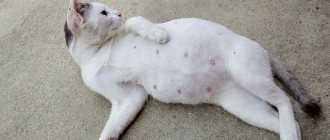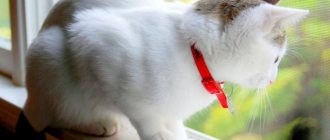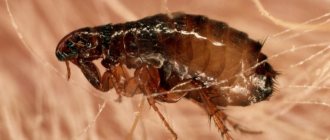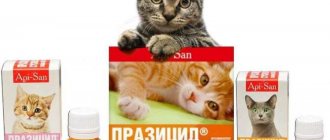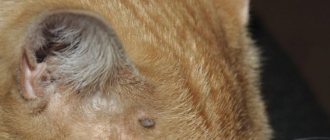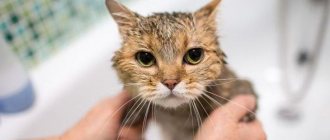Flea drops for kittens
Flea remedies for kittens must be selected with special care, because many of them can have an extremely negative effect not only on parasites, but also on the pets themselves.
When choosing flea drops for kittens, you need to focus on the age of the kids. In the first months of life, kittens still have too weak an immune system. Drops, which contain highly toxic substances, can cause much more harm to a pet’s health than fleas, and even lead to its death.
That is why it is advisable to use such drugs to treat a pet only after it reaches 2–3 months of age.
If the baby is breastfed, before flea treatment you need to assess the degree of its infestation. Cats lick their kittens, and this helps them to some extent get rid of parasites. However, it is precisely because of regular licking that all substances applied to the baby’s fur will inevitably end up first in the cat’s gastrointestinal tract, and then through the milk and to the kitten.
For this reason, if the number of parasites is small, it is better to rid the kitten of fleas when breastfeeding is completed.
Important! Owners should remember that it is strictly prohibited to remove fleas using insecticidal preparations for sick and weakened kittens.
We create conditions so that the kitten does not get sick
To avoid infection, the breeder has the right to take preventive measures. Basic tips:
- daily examination of your pet for the presence of parasites;
- use of insecticides;
- frequency in the house;
- limited contact with non-domestic pets.
If it was not possible to avoid infection, then drastic measures must be taken to ensure a speedy recovery of the pet.
Soaping the composition
Soaping the composition is a complex process and you can’t do it without an assistant. Cats rarely like to take baths, so you need to hold your pet and thoroughly rub in the shampoo, avoiding the area around the eyes and face.
Carefully distribute the required dose over the entire body, including the abdomen, allow it to be absorbed, and then rinse off. Under no circumstances should you allow your cat to lick you for 10 minutes.
To avoid getting the product into your ears, you must first plug them with cotton tubes, which should be moistened with vegetable oil. It is necessary to rinse the kitten's fur thoroughly so that no chemicals remain.
How to dry your pet's fur
Drying a kitten after taking a bath is an important operation that preserves its health, because the body of babies is not protected from the effects of the sun and cold, as well as drafts. One drying method is to use a hair dryer. But you need to do this wisely. You can’t point it at the muzzle; you need to turn on the medium mode.
If the cat is afraid of the sound made, then you need to purchase a quieter device or use a heater-wind blower. The cats always move closer to him and are not afraid of him.
After taking a bath you should not:
- Remove the towel and immediately allow the cat to dry itself.
- Lock the animal in a cold room with an open window.
- Screaming while bathing and drying.
- Keep in a wet towel for a long time.
- Leaving the cat wet.
After blow-drying, comb the kitten and then reward it with a treat.
What to do if a kitten is poisoned by a drug
First provide first aid. Then go to the veterinary clinic and explain everything to the staff. Unlike an adult, a kitten’s infection develops quickly and the consequences can be more serious.
Regardless of what poisoned the kitten, you need to provide first aid. To reduce the concentration of the substance that caused the poisoning, it is worth giving the kitten water. If he refuses water, you need to pour it through a pipette.
If the substance gets through the fur, immediately bathe the pet. In case of chemicals that have got inside, you need to give 2 tablets of activated carbon and take the kitten to a veterinary clinic. Explain the cause of poisoning to provide effective assistance to your pet.
Where can a kitten get fleas?
Unfortunately, fleas appear on kittens quite often. And not only among street kids, but also among domestic kittens.
Female fleas throw out fertilized eggs over fairly long distances as they move. They roll off the cat's fur and accumulate in the corners of the apartment. Subsequently, larvae emerge from the eggs, and then pupae, which are ready to wait for their prey for months, even under unfavorable conditions.
There are several ways kittens can become infected with fleas:
- Other animals. Babies can become infected with external parasites not only from their mother, but also from other pets who live in the house and have free access to the outside.
- Human. Fleas in newborn kittens can appear after direct contact with the owner's outdoor clothing or shoes.
- Rodents. Sometimes kittens pick up fleas after hunting mice or other rodents.
- Street. If kids have the opportunity to go outside, they are almost 100% likely to become infected with fleas.
Fleas cause serious damage to the health of animals. That is why owners need to identify symptoms of infection as soon as possible and take measures to rid the kitten of fleas.
Features of the insect
What are fleas? These are blood-sucking parasites. They are quite unpretentious and tenacious. Squashing a flea is not easy because of its body structure. The parasite has legs designed for jumping long distances. Fleas can go without food and survive for weeks this way. These insects are very prolific, which also poses a serious problem.
What do fleas look like and why are they dangerous?
Fleas have a mouthpart that allows them to bite through the skin of an animal and feed on its blood. Thanks to their laterally flattened body and small, rounded head, insects can move quickly through cat fur. On the surface of the flea's body there are bristly ridges, which also help the parasite cover distances on the animal's body. The flea has six legs, the back two of which are especially well developed. This allows fleas to jump up to half a meter.
These parasites pose a serious danger primarily to kittens, as well as weakened, sick and old animals. Fleas can cause anemia in kittens because one parasite drinks large amounts of blood. In the most advanced cases, fleas can lead to the death of the animal.
In addition to the fact that fleas feed on the blood of animals, they are also carriers of many dangerous diseases. For some types of helminths, fleas are an intermediate host. An animal can accidentally swallow a flea and then the helminth eggs enter the body directly, where they become larvae and then turn into adult parasites.
At the same time, the cat’s skin and fur also suffer greatly. The coat may fall out, lose shine and look unkempt.
Types of fleas in cats
The most common flea that affects cats is C felis, also known as the cat flea. The size of parasites of this species is small - from 2 to 4 mm. They do not have wings, and their small head and laterally flattened body allow them to easily move among the cat’s fur, clinging to the hairs with bristles and spines.
Where do fleas come from?
Fleas are parasites that are active all year round. They live not only on the street, but also in the basements of residential buildings and entrances. You may not even notice the larval eggs hidden in the corners of your apartment: behind baseboards, in cracks, in furniture and folds of linen. The larvae feed on dust and other contaminants, and then, upon reaching sexual maturity, migrate to a pet. Therefore, even a domestic cat can become infected with parasites that you accidentally brought from the street on your clothes or shoes.
Symptoms of flea infestation
You won't be able to avoid noticing fleas on your cat for a long time. The animal quickly begins to show the following signs of the disease:
- An infected cat begins to actively scratch and bite itself, trying to catch parasites.
- The animal is nervous and meows.
- Black crumbs on the skin are parasite excrement and dried blood from scratching bites.
- When examining the cat's back or scruff, you may notice bite marks.
- The presence of fleas themselves on the animal’s fur.
Are fleas the same on dogs and cats?
It happens that dogs and cats suffer from the same type of fleas. Dogs and cats can be parasitized by a specific type of parasite - the cat flea. At the same time, there is also a dog flea, which parasitizes exclusively on dogs.
How often can fleas be poisoned?
The procedure for killing fleas using special drops is carried out once. If necessary, the procedure is repeated after two months. At the same time, the room is treated with special means: the floor, baseboards and the animal’s sleeping area.
How to detect parasites
Fleas in kittens can only be detected with careful examination or if there are too many parasites, but outwardly the baby may look quite healthy.
Characteristic signs of a kitten being infected with fleas:
- The pet often itches, and he begins to do it very sharply.
- Flea excrement in the form of small black particles or flea eggs can be found on the neck, ears and stomach.
- Non-healing wounds and scratches appear on the animal’s skin.
- The baby is inactive, weak, eats poorly, and loses weight.
- Your pet's fur is falling out.
- The pet sleeps very restlessly.
Important! In particularly advanced conditions, the baby may develop dermatitis, dermatophiliasis and other ulcerative skin lesions.
Preventive recommendations
To prevent parasites from lingering in your home, it is recommended to clean with a vacuum cleaner as often as possible. The vacuum cleaner bag must be shaken out immediately after cleaning. Thoroughly clean the space under furniture, corners, and cat litter. Clean all areas where the animal is, such as a car or carrier.
Keep your home clean so that pests do not have food in the form of various debris and dust. As a preventative measure, repellents containing pyrethrins can also be used. They help protect the area from fleas.
There are a huge number of ways to deal with fleas in cats. You can use both natural folk remedies and modern medications, collars and shampoos in the fight against these parasites. The main thing is not to neglect the treatment of your pet and carry out preventive measures. As a result, all your efforts put into fighting fleas on your cat will be rewarded with happy purring and love from your pet.
How to remove fleas from small kittens
Of course, every owner wants to remove fleas from a kitten at home as efficiently and safely as possible.
The method of combating parasites depends on the age of the pet: the younger it is, the more limited the range of anti-flea drugs approved for use becomes. For your small pet, you can choose one of the following methods of getting rid of these insects:
- mechanical cleaning by combing;
- bathing with antiparasitic shampoo;
- use of gentle insecticidal preparations;
- the use of various folk remedies.
From 2 days of age
Fipronil Spray is the only drug that can be used to remove fleas from a nursing cat and newborn kittens older than 2 days, as well as from pregnant individuals. However, at the time of applying the spray the animal must be completely healthy.
This preparation must be sprayed over the surface of the animal’s fur (in the direction of its growth) from a distance of 10–20 cm so that it is saturated all the way to the skin. Long-haired individuals will probably need to be combed and then repeated.
The drug should be applied to the face with a rubber glove and gently rubbed into the fur. Then you need to wait for the spray to dry naturally. At this time, the owners will have to make sure that the baby does not lick the drug, since if ingested, the drug can cause increased salivation, vomiting and difficulty breathing.
When treating a pet with this drug, you must follow the dosage: 2–4 presses on the spray bottle per 1 kg of pet’s weight for bottles of 250 and 500 ml or 6–12 presses for bottles of 100 ml.
This drug protects the animal from fleas for a period of 1 to 3 months. If the kitten is often outdoors, the treatment should be repeated every 4 weeks.
From 7 days of age
Fiprist Spray is another drug that can be used to treat kittens against fleas at home if they are one week old.
The product should be sprayed onto the animal’s fur (against hair growth) from a distance of 10–20 cm. To prevent the solution from being licked off before it dries completely, it is recommended to put a special collar on the pet.
It is also necessary to ensure that the drug does not get into the eyes when spraying the chest and ears. Treatment should be carried out outdoors or indoors with open windows. For 2 days before and after using the drug, you should not bathe the baby, stroke him or allow contact with children.
When treating your baby with this product, you must strictly adhere to the dosage: 3–6 ml of spray per 1 kg of weight. In this case, 1 injection for 100 ml bottles is 0.5 ml of the drug dose and 1.5 ml of the dose for 250 ml bottles. In case of an overdose, your pet may experience increased salivation, trembling and vomiting.
This drug destroys not only adult parasites, but also their offspring at all stages of development. The protective effect of the drug lasts approximately 40 days after treatment.
From 6 weeks of age
The BEAFAR SOS flea collar for kittens is designed specifically for babies who have reached the age of 6 weeks. It is practically odorless, safe for kittens and equipped with a special quick-release clasp.
The active ingredient in this collar is tetrachlorvinphos. It does not penetrate the animal’s circulatory system, but spreads through the skin fat. The substance has a negative effect on external parasites even before they bite your pet, which helps avoid the appearance of dermatitis and other skin diseases.
Effects on external parasites begin 5 days after the collar is put on. When worn continuously, BEAFAR SOS provides the kitten with protection against fleas and lice for 8 months, and against scabies and ixodid mites for 4.
Important! Water procedures while wearing the collar do not weaken its effect on parasites.
From 8 weeks of age
Bars Forte drops for kittens are effective against fleas, lice and lice at all stages of their development. This product is available in the form of 1 ml dropper pipettes. The drug contains fipronil. It blocks receptors and leads to paralysis and death of adults, and also regulates the growth of parasites (disturbs the processes of molting and pupation of fleas).
This product is approved for use by healthy kittens over 2 months old. To rid your pet of fleas, you need to treat it with the drug in places that are inaccessible for licking.
The dosage should be as follows: 1 dropper pipette per 1 animal weighing up to 1 kg. If the pet weighs more than 1 kg, then the volume of the drug must be doubled.
For 24 hours after applying the drops, the baby should not be stroked or allowed to come into contact with children.
These drops provide your pet with flea protection for 3 months. Repeated treatment cannot be carried out more than once a month.
From 10 weeks of age
Insecto-acaricidal drops for kittens Dana are used to combat adult and offspring fleas, lice and ticks in kittens that have reached the age of 10 weeks. The drug is available in the form of 0.5 ml pipettes. The active ingredient is diazinon.
It manifests its effect 12–24 hours after application and accumulates in the skin, sebaceous glands and hair follicles.
To treat a kitten against fleas, it is necessary to apply the drug in places inaccessible to licking in the following dosage: 1 pipette for animals weighing less than 1 kg, 2 pipettes for kittens weighing more than 1 kg.
The kitten should not be bathed for 3 days before and after using the drops. The treated pet must not be stroked or allowed near children for 24 hours.
The duration of the protective anti-flea effect of the drug is approximately 2 months. Repeated treatment should be carried out according to indications, but not more than once a month.
How to choose an effective remedy
The most effective flea remedy is one that can expel all parasitic insects without harming the health of the cat and its owners. To choose an effective remedy, you need to remember several criteria:
- pet's age;
- characteristics of the cat (allergies, intolerance to some component, fear of spray bottles, etc.);
- physical condition of the animal (illness, pregnancy, breastfeeding kittens, etc.);
- the specifics of the drug (what qualities it should have);
- in what conditions the product should be used (house, apartment, etc.);
- presence of children in the house, etc.
If you know exactly how, where and why the product will be used, then choosing it will not be difficult. The pet pharmacy employee will ask you the same questions. Even if you have already decided on a specific insecticide, you still have to carefully read the instructions and annotation for the drug to make sure that the choice is made correctly. Based on the analysis of various flea remedies, the following conclusions can be drawn:
- To prevent infection, collars and drops on the withers are suitable. These flea control products have a fairly gentle effect on the pet itself, rarely lead to side effects, but at the same time reliably repel fleas.
- If the animal has few fleas, the best remedy for fleas is a collar or drops.
- In case of severe parasite infestation, it is necessary to resort to the use of special flea sprays or shampoos.
- For pets that regularly go outside but live in the city, collars are suitable. You can remove them at home, and the animal’s skin on the neck will not be irritated.
- Animals that are taken to the country for a long period of time need to have drops applied to their necks.
- Kittens and puppies over the age of one month can be bathed with special shampoos. Older kittens can be treated with drops and put flea collars on them.
- It is not recommended to use any insecticides at all on lactating and pregnant cats. Only if the infection is too severe, threatening serious damage to the offspring, can you use special drops or bathe the animal with shampoos.
In order to rid your cat of fleas without harming its health, you need to approach the issue of choosing the best remedy with all responsibility.
How to remove fleas from kittens from 2 months of age
The list of drugs that can be used to treat fleas when a kitten reaches 2 months of age becomes more diverse. In most cases, to kill external parasites in older cats, you can use the same medications as for adult cats.
However, before the first use, it is advisable to use the product in a small volume in order to assess the reaction of the baby’s body.
Drops
Flea drops are considered one of the most convenient methods of killing parasites in kittens. They help get rid of not only fleas, but also lice and ticks. In addition, the drops provide babies with protection from re-infection for 1 month.
To treat your pet, you need to spread the hair at the withers and apply the drug to the skin in a dosage that corresponds to the age or weight of the kitten.
It is recommended to treat flea drops only in completely healthy babies and kittens who are no longer breastfed, since these drugs are particularly toxic. Otherwise, when licking, toxic substances will enter the cat’s body, and from there into the milk.
According to most veterinarians, the following drops for fleas in kittens are considered the most effective:
- Advantage;
- Bloch Netmax;
- Hartz;
- Stronghold.
Sprays
Sprays are one of the fastest ways to kill fleas on kittens. With the help of such drugs you can kill fleas and their offspring in just a few hours.
Anti-flea sprays are sprayed directly onto the baby’s fur (in the direction of its growth or against it, depending on the manufacturer’s recommendations) in strict accordance with the dosage specified in the instructions. There is no need to wash off such preparations.
The substances that make up flea sprays are particularly toxic. That is why such drugs should only be used for completely healthy kittens that are already feeding on their own. For several hours after applying the product, you should not allow the kitten to lick itself, but it is better to put a protective collar on it and wait for the spray to dry.
It is also recommended to spray all places in the house where the pet lives, and then thoroughly vacuum everything and ventilate the room.
The most effective sprays against fleas in kittens are from the following manufacturers:
- Hartz;
- Frontline;
- BlochNet.
Shampoos
A special anti-flea shampoo for kittens is the safest, but most labor-intensive method of killing parasites in small pets. Many shampoos are allowed to be used from one month onwards, because they are made on the basis of plant extracts.
You can wash your kitten with shampoo as follows:
- First, it is advisable to trim your pet’s nails to protect your hands from deep scratches.
- Fill a basin with warm water. Its temperature should be 38–42 °C.
- Gently wet your pet's fur.
- Apply shampoo diluted in a small amount of water to the baby’s body and paws, lather and hold for 5–7 minutes.
- Rinse the product thoroughly under warm running water so that the kitten does not get poisoned when licking it.
- Wrap your pet in a warm towel.
- Once dry, comb out fleas and their eggs.
Important! During application, be careful not to get the shampoo into the kitten's mouth, nose, or eyes.
To achieve an effective result, the baby must be bathed with shampoo 2-3 more times with an interval of 10 days until the fleas completely disappear.
The following anti-flea shampoos are currently most popular:
- Phytoelite;
- Kiss;
- RolfClub.
Collars
Flea collars are the easiest way to control fleas on kittens. You just need to take it out of the package, put it on your pet and fix it according to the size of his neck.
It is recommended to use a collar if there are several pets in the house, and one of them has fleas. It is also advisable to put a collar on the kitten if the mother has parasites. Such flea remedies are more likely to prevent re-infection, but they are unlikely to be able to completely destroy the insects. For maximum effectiveness, it is recommended to use the collar together with spray or shampoo.
Some kittens experience discomfort from an uncomfortable collar and constantly try to remove it, thereby damaging their skin. Sometimes the substances that make up this flea remedy irritate the delicate skin of babies or cause allergy attacks.
The duration of the protective effect of the collar depends on its price: more expensive options not only “work” longer, but also have a waterproof effect.
Veterinarians consider collars from the following manufacturers to be the most effective:
- Beaphar;
- Foresto;
- Bolfo.
Powder
To destroy external parasites in kittens, it is allowed to use a special anti-flea powder, which is approved for use even by babies a few days old.
The powder must be thoroughly rubbed into dry and intact skin at a dosage of 500 mg of the drug per 1 kg of animal weight, and then comb out the fleas with a comb. The caught parasites should be immediately sent to a pre-prepared container of water so that they do not jump back onto the pet.
After treatment, the kitten must be isolated from its mother for 3–4 hours and fed independently so that toxic substances from the drug do not enter the cat’s body and then into breast milk.
Powder is considered the safest for kittens:
- Gamma;
- Hartz;
- Beaphar.
Traditional methods
You can get rid of fleas on a kitten at home without the use of special chemicals. This is especially true if the baby is less than 2 months old. Traditional methods are gentle and harmless, but sometimes tedious and not effective enough. But if you have no choice, it's worth trying them. How to remove fleas from a kitten using traditional methods: manually or using natural remedies.
Mechanical removal
By rights, the safest method of getting rid of fleas is mechanical, which allows you to remove insects even from newborn kittens. At the same time, it is the most labor-intensive and time-consuming, since it is not possible to quickly get rid of fleas by combing due to the presence of numerous clutches of eggs.
To carry out the procedure, you will need a hard plastic comb with frequent rounded teeth and a white sheet of paper. Combing fleas should begin from the back, gradually moving to the abdomen and paws. It is not recommended to manipulate the pet's head - you can injure the kitten's ears, nose and eyes. Any fleas on the paper should be immediately crushed or thrown into a container of water. The processing comb also needs to be periodically cleaned of accumulations of insects and hair.
You need to carry out the procedure twice a day until the fleas disappear. One combing session should take about 10 minutes on average. As a rule, it takes 1 month to solve the problem. Afterwards, it is necessary to check the fur for several weeks, since new individuals could emerge from the remaining eggs.
Bathing
Plain water will not get rid of fleas. But if you add salt, tansy or wormwood to the bath, the insects will begin to disappear.
Salt bath. Add table salt to warm water at the rate of 1 tbsp. 200 ml, dissolve. Place your pet in the solution for 10 minutes. Then pat the fur dry with a towel and comb out with a comb. Repeat the procedure every week.
A decoction of wormwood or tansy. Brew the chopped herb in boiling water (1 tablespoon per glass). Prepare a warm bath and pour in the infusion. Keep your pet in the solution for several minutes and dry the fur well. The procedure can be carried out several times a week.
Important! When bathing, be careful not to get water into your pet's ears, nose or eyes!
Tar soap
This flea remedy for kittens is completely safe and quite effective. The soap needs to be turned into thick foam. To make the process easier, you can grate the piece and dissolve it in warm water. The foam should be rubbed into the pet’s fur and rinsed off after a few minutes. To remove dead insects, you can comb the fur after drying.
Additional measures
Unfortunately, if you destroy the parasites in a kitten's fur, it is unlikely that you will be able to completely get rid of them. Fleas and their larvae can live not only in the fur of animals, but also in carpets, folds of clothing, upholstered furniture, pet bedding and other secluded corners of the house.
That is why, to completely get rid of fleas, it is recommended to do the following:
- Treat all pets living in the house with insecticidal preparations.
- Carry out a thorough cleaning of the entire house: vacuum carpets and upholstered furniture, if possible treat them with a steam generator, wash the floor and other surfaces.
- Throw away your pet's old sleeping place or treat it with disinfectants and then wash it.
- Disinfect the apartment using special flea products (Raptor, Raid and others) according to the instructions for their use.
Signs of a flea infestation
A flea infestation in a pet is easy to recognize. The cat’s condition and behavior changes significantly:
- The cat often scratches itself behind the ear and feverishly licks its entire body. This licking becomes nervous and obsessive.
- Bite marks are small red dots on the skin that look like needle marks.
- Redness and irritation of the skin, scratching.
- Rough, scaly spots on the skin are a sign of an allergy (flea dermatitis).
- Hair loss in affected areas.
- Poor appetite indicates a serious deterioration in health: dermatitis, worms, anemia, infections.
- White long worms in stool or near the tail. If your cat gets tapeworms, it means he has fleas.
- When a cat is brushed, reddish-brown husks may fall out of the fur - this is flea excrement.
Sometimes you can see fleas crawling on the fur. They must be caught and destroyed immediately. The proliferation of parasites in an animal’s fur leads to the development of severe pathologies that can kill the pet.
When not to use chemicals
The use of specialized preparations containing insecticides is permitted only for kittens that have already been weaned. This is due to the fact that the cat instinctively constantly licks its offspring, which leads to the ingestion of a toxic substance and subsequently severe poisoning and even death.
Until two weeks of age, no methods of handling a small animal, even bathing, are allowed. The baby has a weak immune system, so toxic exposure causes poisoning and death of the kitten.
Side effects
All prophylactic drugs intended to combat parasites are toxic. Drops released for treating kittens are usually classified as moderately toxic substances. It is important to understand that the conditional safety of the drops implies exclusively external use and the absence of an individual allergic reaction.
If you are treating a kitten with an unknown medical history, you should use the safest possible drops and consult your veterinarian first. In most cases, kittens picked up on the street or bought at a poultry market are infected not only with fleas, but also with worms. In case of mixed invasion, it is much more reasonable to use complex drugs (for external and internal parasites) in the form of drops.
Kitten itches after flea drops
In rare cases, if there is an individual intolerance to the active ingredients of the drops, the animal may experience an allergic reaction. If the kitten itches after flea drops, it is necessary to inspect the treatment area. Alarming symptoms are: redness, swelling and local fever. If you notice symptoms of an allergic reaction, the remaining droplets must be washed off from the kitten’s fur and skin.
In the absence of an allergic reaction, after treatment with drops, the kitten may itch during the day. The fact is that most drops quickly paralyze fleas, but the death of parasites can occur within several hours. An allergic reaction to already inflicted flea bites can last up to 12–20 hours. In addition, gentle drugs can only affect adults. In this case, the treatment is repeated after 4–10 days (according to the instructions or prescription of the veterinarian).
Apartment processing
An important step in getting rid of parasites is treating the apartment, since 80-90% of flea eggs and larvae are not on the cat, but on household items: carpets, upholstered furniture, cracks in walls and floors, etc. General cleaning and disinfestation of the apartment will allow up to finally solve this problem.
The algorithm is as follows:
- Remove people and pets from the premises. Wear gloves, goggles, and a respirator. Treat furniture, walls and floors with antiparasitic drugs.
- Leave the apartment for 12 hours, and then ventilate it for 2-3 hours.
- Vacuum all surfaces, especially carpets, upholstered furniture, corners, and the floor under furniture.
- Wash and boil soft toys, bed linen, bedspreads, blankets.
- Carry out wet cleaning by adding essential oils of lavender, geranium, pine, tea tree, and eucalyptus to the water.
If necessary, all procedures should be repeated after 3-4 weeks. In this way, not only adult fleas will be destroyed, but also flea eggs.
Contraindications and side effects
The only absolute contraindication to the use of anti-flea drops is the cat’s individual intolerance to the components of the drug. Veterinarians recommend carrying out the following test before application: drop a little product on the withers and observe the pet for 24 hours. If after this time no redness or swelling has appeared, and the animal’s well-being has not worsened, then you can safely begin flea treatment.
Owners should not give cats multiple flea medications at the same time. In this case, the pet may experience an overdose, which poses a great threat to its life and health.
Owners should also carefully study the composition of anti-flea drops before treating their cat. Permethrin products paralyze and kill fleas, but can also kill a cat. Previously, products containing this substance were widely used to treat animals. However, according to recent research by scientists, they are very toxic to cats not only when ingested, but also when applied to the skin, and, on the contrary, are harmless to dogs. That is why manufacturers now include permethrin exclusively in anti-flea drops for dogs. Unfortunately, some owners think that the organisms of these animals are similar, so they treat their cats with flea products for dogs, which can lead to irreparable consequences.
Contraindications to the use of most anti-flea drops in cats may include:
- pregnancy;
- lactation;
- age up to 2 months;
- too little weight;
- feeling unwell due to illness.
In addition, you cannot treat a cat for fleas if it has had surgery and less than 3 weeks have passed since the stitches were removed.
If the instructions for use are not followed, the cat may experience various side effects after applying flea drops:
- dyspnea;
- vomit;
- diarrhea;
- muscle tremors;
- increased salivation;
- lacrimation;
- itching
Important! If any side effect occurs, wash off the drug and immediately show the cat to a veterinarian.

